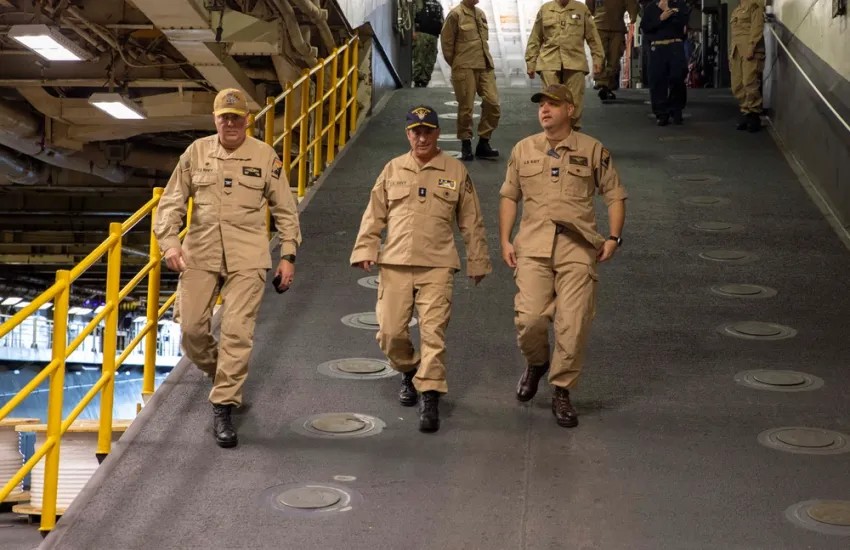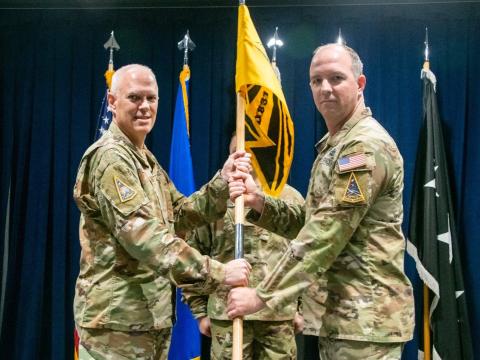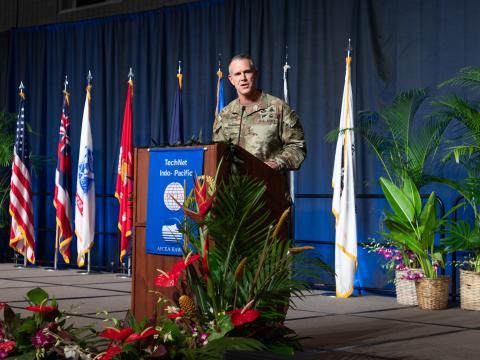Today’s Maritime Warfighting Needs Global LVC Platform
With the U.S. military eyeing 2027 as a timeframe of possible war with the People’s Republic of China, modeling and simulation (sim) environments, specifically live, virtual and constructive (LVC) platforms, need to be more sophisticated than ever before, maritime leaders said.
The U.S. Navy and the U.S. Marine Corps do not have the LVC capabilities today that allow sailors and Marines to exercise the full spectrum of capabilities needed for combat operations across all echelons.
Speaking at WEST on January 28 in San Diego with a panel of maritime leaders, Lt. Gen. Michael Cederholm, USMC, commanding general, I Marine Expeditionary Force (MEF), acknowledged that the Marine Corps was not quite there with LVC for tomorrow’s fight.
“The short answer is no, not yet,” he said. “What we need to be able to do that we currently cannot do, is we need to be able to rehearse and do operations across three things: all domains, all echelons and across all functions. We're not there yet.”
Cederholm does have confidence in the plan to expand LVC that now-retired Lt. Gen. Kevin Iiams put in place in 2023. Iiams, the former commander of the Marine Corps Training and Education Command who retired in 2024, advanced the so-called Project Tripoli, a four-year effort that included four phases.
“Lt. Gen. Iiams put us on an LVC training continuum project beginning in Fiscal Year 23,” Cederholm explained. “Right now, we've just entered the integration phase of LVC for the Marine Corps. And then at the beginning of 26, we go into global integration space….I have the utmost trust and confidence in that, and they have been on the glide slope since 23, delivering on the objectives and the wickets along the way.”
The I MEF commander does see more LVC environments coming into the necessary operational and tactical levels.
In fact, the service is starting to incorporate LVC into some of its large-scale exercises, such as Exercise Balikatan 24, that was held last year between March 26 and May 9, 2024. The exercise involved about 16,000 service members from the Armed Forces of the Philippines and the United States with warfighters from all of the two countries’ air, land and sea services.
For the 2025 Balikatan exercise, the Marine Corps is planning to expand the LVC environment even more.
“Last year we held the first live, virtual and constructive formations battle-sim test, and this year we will scale that up in Balikatan 25,” Cederholm shared. “It was kind of cutting-edge."
They also incorporated LVC into Exercise Steel Knight 24, held from December 2-19, 2024, at Marine Corps Base Camp Pendleton, Beale Air Force Base, and San Clemente Islandin California, and at Marine Corps Air Station Yuma, Arizona. Marines and Navy sailors from the I MEF U.S. Third Fleet and Air Force airmen conducted the annual exercise aimed at enhancing joint mission readiness, joint interoperability and Marine Corps’ force readiness.
“We also did Steel Night, and during the mock certification, during the workup and certification phase for our Marine Rotation Force-Darwin, we used some cutting-edge LVC capabilities, both on the Navy and the Marine Corps side,” Cederholm said.
For the Navy, the use of LVC is improving but also not to the necessary levels, said Vice Adm. John F. G. Wade, USN, commander of the U.S. Third Fleet.
“I would just echo that,” Wade said. “Where we are today, compared to five years ago, when I was the director of Maritime Operations and Fleet Forces, is better, but we got to continue to make our progress.”
He does see that the use of LVC is most advanced in the Navy’s surface fleet. “And we are getting better in aviation," Wade stated. “We are also integrating at the operational level of war."
However, as the Navy integrates more unmanned assets, including both underwater and surface vehicles, more LVC platforms are needed to aid the service’s unmanned-manned integration. “That is coming, and it's coming fast, and that is part of LVC,” Wade suggested.
In addition, any LVC platform needs to account for the difference in East Coast and West Coast operations, the commander continued. “There's a number of factors for that, but there's a lot of money that's being put toward that,” he said. “And when I look at joint force and our allies and partners, it's about improving each exercise [with LVC]. And there is still more to do to get those sets and reps across the joint force.”
Rear Adm. Joseph Cahill, USN, commander of the Naval Surface Force Atlantic, emphasized that LVC allows the military to perform battle rehearsals, a very important piece in warfare.
“It is about all domain operations, about the value of the ARG MEU [the amphibious readiness group and the marine expeditionary group], and it's about the value of the carrier strike group,” Cahill stated. “That is the bottom line, executing combat operations across all domains. So, the piece for me is that LVC enables us to do rehearsals, and that's a key word.”
He did want to share that LVC has improved, from being able to operate in it for about three hours to nowadays at a 24/7 schedule, but that it must grow to a global use scale.

We are training to that now, and we are leveraging live, virtual and constructive platforms inside of exercises like Atlantic Alliance. But there's work to be done.
For Lt. Gen. Calvert Worth, USMC, commanding general, II MEF, the MEF is working with the Marine Corps Warfighting Laboratory and the Naval Information Warfare Center-Atlantic to improve the LVC systems that are already part of their programs of record, such as their Advanced Field Artillery Tactical Data System (AFATDS) or all of their command and control architectures.
“Those systems we are training and working on with our naval counterparts to ensure that as we sense and make sense of the environment, and as we gain and maintain target quality tracks, we can pass that information seamlessly into the MOC [the Marine Corps Operating Concept], for prosecution of said targets, or in a broader sense, be able to hand off those targets that have been tracked and have the level of quality those targets handed off to a joint force or allied partner for prosecution of targets.”
The MEF is training on the Eastern Seaboard to make sure that its battle sim centers are advancing sensor to shooter capabilities for targeting, especially with naval fleets.
“We are training to that now, and we are leveraging live, virtual and constructive platforms inside of exercises like Atlantic Alliance,” he said. “But there's work to be done. There is feedback at the tactical edge for the individual user that needs to be improved.”
The general emphasized that LVC needs to be further integrated into logistics.
“We tend to fairy dust and forward present formations without actually working through the logistics of a contested environment,” he stressed. “This is causing our logisticians to really work through what it means to conduct distributed operations in a maritime domain, in a contested environment where the adversary is going to confuse and frustrate your efforts to keep those distributed formations sustained. So, we need to make sure that we build live, virtual and constructive platforms to challenge ourselves a little bit more distinctly.”
The II MEF commander also recommended the application of LVC to information sharing, training how to better share information across the firewalls. “This is a challenge,” he said. “There's more work to be done, but live, virtual and constructive will allow us to work the challenges and train as we will fight along the Eastern Seaboard, from Halifax to Avon Park, because that is exactly what we are going to be asked to do against a pacing threat.”
To industry, Wade recommended that companies prepare to meet that challenge of building more sophisticated LVC environments, warning that it would not necessarily be easy.
“For industry especially, I don't want to sugarcoat it,” he stated. “There is an East Coast, West Coast thing. And it is not just an easy plug and play. There are some challenges, some configuration variants. And with all our weapons and sensors, the ones and zeros don't necessarily translate to systems that were not built to be integrated. There's a lot of Band-Aids. And so, as we look to the future of LVC with industry, we got to make it a more sophisticated plug and play, and be able to adapt to spiral in new sensors, new software, firmware and hardware.”
Lastly, Cederholm emphasized that he was “excited at the opportunities that lie off the bow with LVC; but we're not there yet from a Marine Corps perspective.”
WEST is co-hosted by AFCEA International and the U.S. Naval Institute. SIGNAL Media is the official media of AFCEA International.






Comments